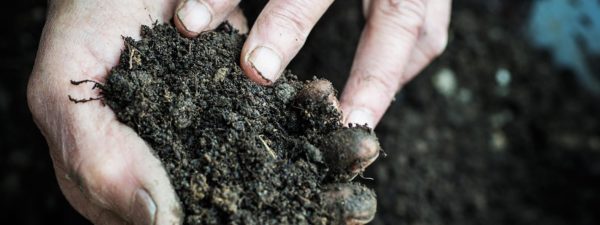Origins, composition and action of the various sources of organic matter
The organic matter contained in a soil depends on both input flows (fertilisation, crop residues, etc.) and output flows through mineralisation. These inputs and outputs are determined by a number of parameters, including soil type, climate, cultivation practices and the origin and composition of the organic matter.
The two origins of organic matter are animal and plant.
Depending on their origins, the compositions of organic products may vary and lead to different mineralisation and humification dynamics in the soil.
Nitrogen-rich plant matter (e.g. soya cake) or animal matter (e.g. feather meal) is rapidly broken down and mineralised by soil micro-organisms. As such, they play more of a nutritional role for the plant.
Plant matter, rich in cellulose and lignin, is broken down more slowly into the soil. They stimulate biological activity in the soil and the formation of the clay-humus complex. In other words, they act as an organic soil improver.
Plant matter, rich in lignin and tannins, transforms very slowly in the soil. They essentially contribute to adding very stable organic matter to the soil.
This knowledge of the origin of organic matter enables us to better select our raw materials for the actions and dynamics of the products we formulate….
Organic fertilisers
They play a wide range of roles, from improving the biological properties of the soil and the rhizosphere to plant nutrition.
- Amendments (standards), as their name suggests, are soil quality improvers such as VEGETUMUS, VEGEVERT, ORGANIC VEGETAL. The addition of digestible carbon to the soil will take action on the physical, chemical and biological properties of the soil, thereby providing assurance for plant production. They act on the carbon cycle (soil carbon storage) and on biological activation (functional biodiversity).
- Fertilisers have a targeted action on plant nutrition, the concept of “fattening”. They can be organic (standards) such as ORGA 3, EVER, ORGANIC ÉQUILIBRE or organo-mineral such as ACTIMUS or TÉNOR 5 5 10. Frayssinet formulations combine both an action on the soil (composted organic base) and an action on plant nutrition. The concentrated organic and/or mineral supplements they contain will ensure balanced and continuous plant nutrition. The technical nature of the formulations is a major factor in nutritional performance.
Indicators for selecting the right organic or organo-mineral fertiliser
Nutritional content
Organic or organo-mineral fertilisers have different balances of major elements (N, P, K, Mg, etc.) and trace elements, depending on how the raw materials are formulated.
For example, ORGA 3 has an N-P-K + Mg nutritional balance of 3-2-3 + 3, i.e., for 100 kg of raw product: 3 kg of N, 2 kg of P2O5, 3 kg of K2O and 3 kg of MgO. The nutritional balance of the fertiliser should be adapted to the resources already present in the soil and to the needs of the crop.
The rate and weight of organic matter
Organic or organo-mineral fertilisers always have an organic matter rate (OMR) which represents the organic matter content in % of the raw product. This OMR should always be viewed as a percentage of the gross product (GP). It is easy to increase the OMR by expressing it in terms of dry matter.
The weight of organic matter (WOM) gives additional information on the mass represented by OM in the total mass of the finished product. This indicator can be used to compare products and assess the organic quality of the product.
C/N Carbon-nitrogen ratio
The ratio of carbon to nitrogen is an indicator of the degree of evolution of organic matter and its ability to decompose more or less rapidly in the soil. An organo-mineral or organic fertiliser ideally has a C/N of less than 10.
Below this level, the product has a rapid mineralising action. The fertiliser will rapidly supply mineral elements to the crop.
Above this level, the product contains more carbon and has a weaker mineralising action.
C/N is an indicator that can also be used to classify fertilisers for use in accordance with the Nitrate Standard.
Type I: C/N greater than 8: organic soil improvers, bulk soil improvers and organic fertilisers
Type II: C/N less than 8: organo-mineral and organic fertilisers
Type III: mineral fertilisers.

